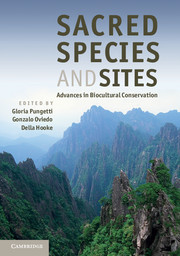Book contents
- Frontmatter
- Contents
- List of Contributors
- Foreword
- Preface
- Acknowledgements
- Introduction
- Part I Concepts and Knowledge
- Part II Sacred Landscapes
- 5 Ecological and spiritual values of landscape: a reciprocal heritage and custody
- 6 Sacred mountains and national parks: spiritual and cultural values as a foundation for environmental conservation
- 7 The history of English churchyard landscapes illustrated by Rivenhall, Essex
- 8 Exmoor dreaming
- Part III Sacred Sites and People
- Part IV Sacred Species
- Part V Sacred Animals
- Part VI Sacred Groves and Plants
- Part VII Implementation and Conclusions
- Index
- Plate Section
- References
8 - Exmoor dreaming
from Part II - Sacred Landscapes
Published online by Cambridge University Press: 05 August 2012
- Frontmatter
- Contents
- List of Contributors
- Foreword
- Preface
- Acknowledgements
- Introduction
- Part I Concepts and Knowledge
- Part II Sacred Landscapes
- 5 Ecological and spiritual values of landscape: a reciprocal heritage and custody
- 6 Sacred mountains and national parks: spiritual and cultural values as a foundation for environmental conservation
- 7 The history of English churchyard landscapes illustrated by Rivenhall, Essex
- 8 Exmoor dreaming
- Part III Sacred Sites and People
- Part IV Sacred Species
- Part V Sacred Animals
- Part VI Sacred Groves and Plants
- Part VII Implementation and Conclusions
- Index
- Plate Section
- References
Summary
Introduction
‘“Exmore”…is “a filthy, barren, ground”’ – so said Daniel Defoe in his three-volume work Tour through the Whole Island of Great Britain published between 1724 and 1726, citing the comments of William Camden in his Britannia first published (in Latin) in 1586 (Furbank et al., 1991, p. 113). Writing in the Exmoor Official National Park Guide Book at the beginning of the twenty-first century, Brian Pearce (2001) describes the region as ‘a seemingly benign landscape in which one immediately feels at home’. In this chapter I will discuss how a barren wasteland became a sacred place in the modern English imagination. I will be focusing on Dunkery Beacon, the highest point on Exmoor, an upland region of south-west Britain.
Daniel Defoe made his dismissive report on the landscape around Dunkery Beacon prior to Exmoor's enclosure for agricultural improvement. Enclosure was never fully achieved and the modern landscape is described in the guide book as a harmony between high moorland and the ‘cosy’ hamlets and farms found at lower levels. It is this tension between cosy habitation and wild moorland that generates Exmoor's sacred quality or spirit of place.
The wild moorland, or in Christian Norberg-Schultz’swords, ‘cosmic landscape’, does not offer humanity sufficient existential foothold (Norberg-Schultz, 1979, p. 45). To enable human dwelling in an ostensibly barren waste, such landscape becomes a habitat for modern imagination. The open moor has become not only a resource for biodiversity, but also a naturalised resource for the guided dreams of an urbanised population.
- Type
- Chapter
- Information
- Sacred Species and SitesAdvances in Biocultural Conservation, pp. 111 - 124Publisher: Cambridge University PressPrint publication year: 2012
References
- 1
- Cited by

